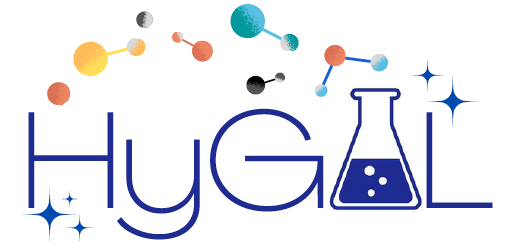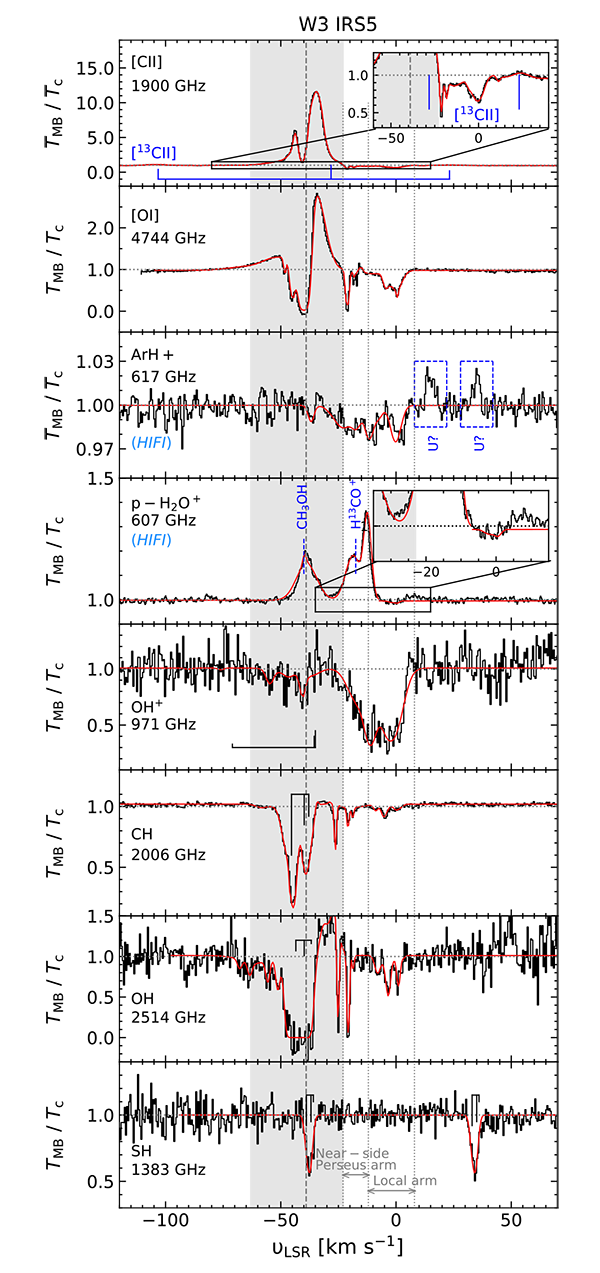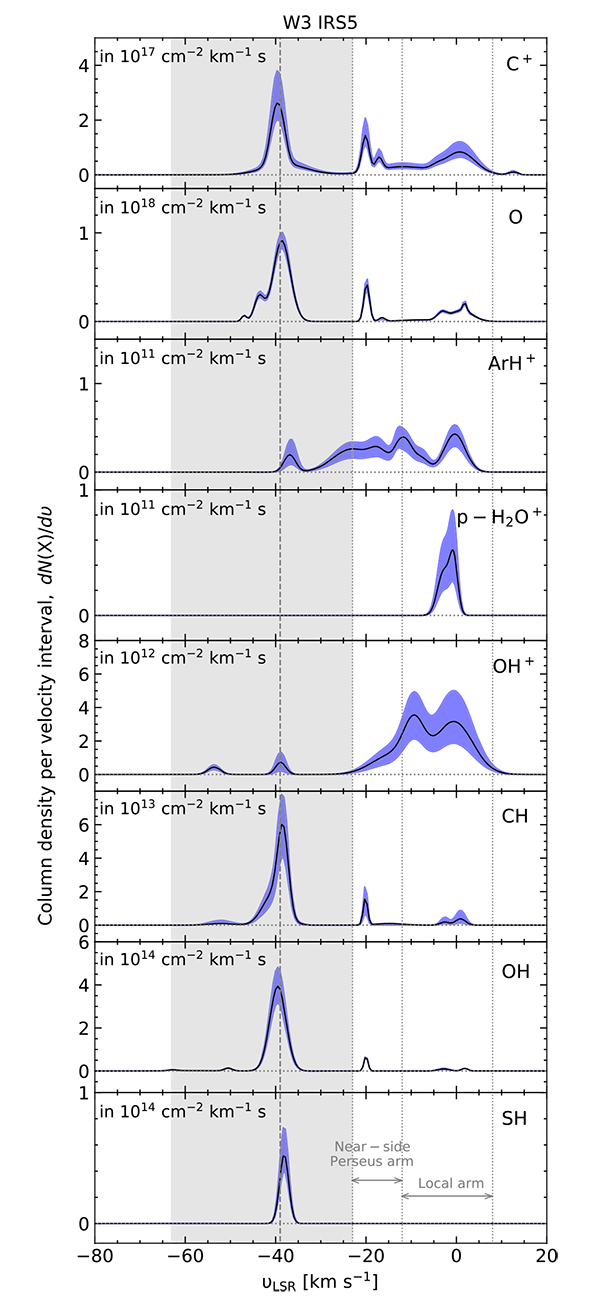Purpose of the Program
Bright infrared were used as continuum illumination to measure absorption due to interstellar hydrides along the line of sight.
Co-Principal Investigators
David Neufeld (Johns Hopkins University) and Peter Schilke (University of Cologne)
Proposal ID and Data Access
Proposal Abstract
By means of absorption-line spectroscopy towards 25 background terahertz continuum sources widely distributed within the Galactic plane, we will obtain robust measurements of the column densities of six hydride molecules (OH + , H 2 O + , ArH + , SH, OH and CH) and two key atomic constituents (C + and O) within the diffuse ISM. Recent studies with Herschel have demonstrated the unique value of specific hydride molecules as quantitative diagnostic probes of the H 2 fraction, the cosmic-ray ionization rate, or of “warm chemistry” associated with the dissipation of interstellar turbulence in regions of elevated temperature or ion-neutral drift. These observations will allow us to address several related questions:
- What is the distribution function of H 2 fraction in the ISM?
- How does the density of low-energy cosmic-rays vary within the Galaxy?
- What is the nature of interstellar turbulence (e.g. typical shear or shock velocities), and what mechanisms lead to its dissipation?
Because of atmospheric absorption, the transitions to be observed in this program are inaccessible from the ground and can only be observed from airborne or satellite observatories. Our investigation is synergistic with ancillary observations of non-hydride molecules that have been/will be performed with ALMA, JVLA, the IRAM 30 m telescope, and the APEX 12 m telescope. There is a very timely synergy with theoretical models for H2 formation within the turbulent ISM, several of which are under development by groups within our team.
The anticipated results are:
- a determination of the distribution function for the H 2 fraction in the Galaxy, and how it varies;
- a determination of the cosmic-ray ionization rate and how it varies;
- an improved characterization of turbulence in the diffuse ISM, and its dissipation;
- the provision of enhanced data products that will serve as a legacy for future ISM studies
Download the HyGAL Proposal
Publications
HyGAL. I. Survey Description and a First Look Toward W3(OH), W3 IRS5, and NGC 7538 IRS1, by Jacob, A. M., Neufeld, D. A., Schilke, P. et al 2022, ApJ, 930, 141
HyGAL. II. The absorption line survey with the IRAM 30 m telescope, by Kim, W.-J., Schilke, P., Neufeld, D. A., et al. 2023, A&A in press ( arXiv:2212.09334 )
HyGAL: Ancillary Observing Programs
Observations of HI and OH with JVLA: accepted proposal
Observations of H2S, C2H, HCO+, HCN, HOC+, HNC, CS, and SO with IRAM: accepted proposal
HyGAL Targets
Click on image for a larger version.
Click on image for a PDF version.
HyGAL Species
Click on image for a PDF version.
HyGAL: Observations Completed
The program was 70% completed (56.6 hr out of 81.6 approved) before the SOFIA mission was terminated in September 2022.
Click on image thumbnails for a larger version. Empty cells in the table are for spectral lines not observed for that source.
| Source |
ArH+/H2O+
Observation (Status) |
OH+
Observation (Status) |
SH
Observation (Status) |
OH
Observation (Status) |
CH
Observation (Status) |
CII
Observation (Status) |
OI
Observation (Status) |
Data Links | Publication |
|---|---|---|---|---|---|---|---|---|---|
| DR21 |
|
|
|
|
|
|
|
||
| G09.622+0.19 |
|
|
|
||||||
| G10.47+0.03 |
|
|
|
|
|
|
|||
| G19.61-0.23 |
|
|
|
|
|
|
|||
| G29.96 -0.02 |
|
|
|
|
|
|
|
||
| G291.579-00.431 |
|
|
|
|
|
||||
| G31.41+0.3 |
|
|
|
|
|
||||
| G32.80+0.19 |
|
|
|
|
|
|
|
||
| G327.3-0.6 | Jacob+19, Wiesenmeyer+16 | ||||||||
| G328.307+0.423 |
|
|
|
|
|
||||
| G357.558-00.321 |
|
|
|
|
|
|
|||
| G45.07+0.13 |
|
|
|
|
|
|
|
||
| HGAL0.55-0.85 |
|
|
|
|
|
|
|||
| HGAL284.015-0.86 |
|
|
|
|
|
||||
| HGAL285.26-0.05 |
|
|
|
|
|||||
| IRAS 12326-6245 |
|
|
|
|
|||||
| IRAS 16060-5146 |
|
|
|
|
|
|
|||
| IRAS 16164-5046 |
|
|
|
|
|
Jacob+19 | |||
| IRAS 16352-4721 |
|
|
|
|
|
||||
| IRAS 16547-4247 |
|
|
|
|
|
||||
| NGC 6334 I |
|
|
|
|
|
|
|
||
| NGC 7538 IRS 1 |
|
|
|
|
|
|
ASCII
FITS |
Jacob et al., 2022, ApJ, 930, 141 | |
| W3 IRS5 |
|
|
|
|
|
|
|
ASCII
FITS |
Jacob et al., 2022, ApJ, 930, 141 |
| W3 OH |
|
|
|
|
|
|
|
ASCII
FITS |
Jacob et al., 2022, ApJ, 930, 141 |
| W43 |
|
|
|
|
|
|
|
Example HyGAL spectra, and the column densities they imply
(from Jacob et al. 2022, ApJ, 930, 141)
Click on image for a larger version.
Click on image for a larger version.
Click on image for a PDF version.
















































































































































































